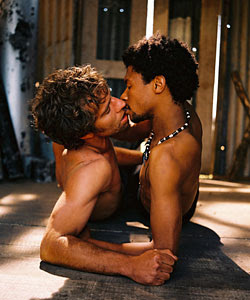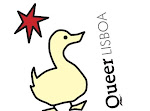

Director: John Greyson.
Principal cast: Rouxnet Brown, Shaun Smyth, Neil Sandilands, Kristen Thomson.
John Greyson's ability to create aesthetically pleasing films in somewhat unconventional ways has always been accompanied by his unquenchable desire to speak up against the injustices of this world. While the issues of AIDS and human rights for homosexuals comprise the main bulk of his work, "Proteus" addresses an even broader range of issues including colonialism and racism which are, still, closely related to homophobia and fight for the universal right to love whoever it may be that you fall in love with, regardless of the gender and colour of the object of your affection.
The film is based on a true story about the fate of Rijkhart Jacobsz, a Dutch sailor and Claas Blank, a black native of South Africa who had assumed a Dutch name. Their story was dug up in the archives related to the infamous Robben Island prison just off shore from Cape Town by Jack Lewis, the script’s co-writer and a South African human rights activist who was adamant that it deserved the attention of a broader audience. The records found in the archives were from 1735 and when carefully studied, they suggested that the pair had been together for at least ten years prior to being convicted of sodomy at the height of the “sodomy panic” which had gripped the Netherlands at that time. In 1730, 70 people were executed in Amsterdam alone for “crimes against nature and mankind” which meant nothing other than that they were gay men, either caught in the act or named by others under torture. South Africa being in the hands of the Dutch settlers protected by the colonial Dutch army apparently succumbed to the same wave of witchhunting. What caught the attention of Jack Lewis was that the record of their trial didn’t contain any references to what they both were and what it was that they had together. It was indeed love that didn’t dare speak its name and Jack Lewis decided that it was about time for it to speak. It took about 7 years of raising funds for the project and carrying it out in collaboration with John Greyson, and the result was a poetic, yet angry film about love versus prejudice and intolerance, humanity versus barbarity.
It isn’t random that the events take place on Robben Island, for it was also there that Nelson Mandela was sent to serve his life sentence in 1964. The film’s authors took a creative approach to drawing parallells between the two eras incorporating elements of the 20th century into what is essentially an 18th century drama. The court’s clerks look like they are taken directly out of the 60’s with their beehive perms and heavily framed glasses. The main sadist among the prison guards is wearing a contemporary uniform. And the bloodthirsty Boer settlers wearing 18th century outfits go chasing after one of our protagonists in a jeep. The mixture of period elements is, of course, fully intentional. And it only emphasises the continued relevance of the film’s message today. In 2008, homosexuality is still punishable by death in Iran, Mauritania, Nigeria, Pakistan, Saudi Arabia, Sudan and Yemen. And one can only speculate whether courts in these countries still follow the Dutch 18th century practice of sending the bill for the executions on to the families of the executed.
The story begins to unfold when Claas Blank is brought before the court after being captured by a local Boer settler and accused of stealing his cattle. Due to lack of evidence he is acquitted of these charges, but is still sentenced to 10 years of hard labour on Robben Island for simply opposing a white settler. On the island, he encounters Rijkhart Jakobz who has ended up in prison after having been caught copulating with another man. Eventually, the two are drawn to each other and start a relationship which they must protect from the watchful eyes of their fellow inmates at all costs. However, their sexual encounters are soon discovered by Virgil Niven, a Scottish botanist who has come to South Africa to study and give names to the different species of Protea, a genus of flowering plants specific to the Cape region first discovered by European botanists in the 17th century. Commissioned by the legendary Swedish botanist, physician and zoologist Carl Linnaeus, he enlists the help of Claas Blank who provides him with Bushman names for the plants and tells him about the local beliefs connected to these plants, otherwise known as sugarbushes. Virgil Niven, who has a wife and a child in Amsterdam, is in fact just another example of a gay man doing what is required of him in front of the society while struggling with his true sexuality. He, too, harbours feelings for Claas Blank but is unable to do anything about it, so he remains just an observer, albeit an active one, of both his own inevitable demise and that of our imprisoned pair.
It was purely coincidental that the former South African Prime Minister and architect of apartheid, Hendrik Frensch Verwoerd suggested that protea be included in the new design of the South African flag, thus almost becoming the country’s national symbol the same year as Nelson Mandela was sentenced to a life in prison. However, it wasn’t random that Virgil Niven was studying these beautiful flowers and giving them names in the film. He named one of the species Protea Blankia, thus paying a tribute to his secret infactuation with Claas Blank who in return said the words which were very central to the film’s message – “I’m proud to be a name”. In all essence, he was saying - I’m proud to have a name, I’m proud to have an identity. It was a clear recognition of him as a human being and his dignity as a human being. Earlier in the film, Virgil explained to Claas not only the new system of nomenclature which Carl Linnaeus had introduced in botanics but also the distinguished scientist's racial classification which consisted of five categories - Africanus, Americanus, Asiaticus, Europeanus and Monstrosus. The “monstrous” humans included not only mythological creatures like the dwarf of the Alps and the Patagonian giant but also the "monorchid" Hottentots, the African people of whom Claas was one himself. Hottentots (now known as Khoikhoi) were basically considered just a more developed form of apes, and Virgil was even quick to point out that they had a Hottentot’s skeleton with horns on display at the Museum of Natural History in Amsterdam. Shockingly, this worldview has still survived among some fundamentalist Christians in South Africa and beyond. In all essence, their point is that since the only humans on Noah’s Arc were white, all the black people must have derived from the apes!
This kind of marginalisation and dehumanisation is also known all too well in connection with homophobia which is still fairly rampant across this planet. “Proteus”, although poetic in tone, is full of outrage and a powerful reminder to all of us why we have to continue our fight for the human rights of all people and that we still have a long way to go before we all “have a name”. Needless to say, Linnaeus eventually changed all the names for the different species of protea invented by Virgil Niven. In a manner of speech, this film restores the name of Protea Blankia to its rightful owner.
Here you can watch the film's trailer (in German)

